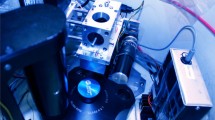Abstract
Analytical ultracentrifugation can provide useful thermodynamic and hydrodynamic information for a wide variety of chemical systems. It is apparent that through the use of modern electronics and computers, analytical ultracentrifugation is undergoing a renaissance. A modernization of ultracentrifugation is underway. The automation of acquisition, reduction and analysis of data has been quite successful. However, what has been more difficult to automate is the art of determining how much information is accessible from an experiment. This is a problem that becomes apparent to anyone starting a project that involves analytical sedimentation.
Access this chapter
Tax calculation will be finalised at checkout
Purchases are for personal use only
Preview
Unable to display preview. Download preview PDF.
Similar content being viewed by others
References
Dierckx P (1987): FITPACK User Guide, Department of Computer Science, K.U. Leuven, Leuven, Belgium.
Fujita H (1975): Foundations of Ultracentrifugal Analysis, J. Wiley and Sons: New York.
Hayes DB (1991): Automated Analysis of Sedimentation Velocity Distribution Functions. Masters thesis, University of New Hampshire, Durham.
Kegeles G and Gutter FJ (1951): The Determination of Sedimentation Constants from Fresnel Diffraction Patterns. J. Am. Chem. Soc. 73: 3770.
Stafford, WF,111. (1992): Boundary Analysis in Sedimentation Transport Experiments: A Procedure for Obtaining Sedimentation Coefficient Distributions Using the Time Derivative of the Concentration Profile. Anal. Biochem. 203: 1.
Editor information
Editors and Affiliations
Rights and permissions
Copyright information
© 1994 Birkhäuser Boston
About this chapter
Cite this chapter
Hayes, D.B., Laue, T.M. (1994). A Graphical Method for Determining the Ideality of a Sedimenting Boundary. In: Schuster, T.M., Laue, T.M. (eds) Modern Analytical Ultracentrifugation. Emerging Biochemical and Biophysical Techniques. Birkhäuser Boston. https://doi.org/10.1007/978-1-4684-6828-1_14
Download citation
DOI: https://doi.org/10.1007/978-1-4684-6828-1_14
Publisher Name: Birkhäuser Boston
Print ISBN: 978-1-4684-6830-4
Online ISBN: 978-1-4684-6828-1
eBook Packages: Springer Book Archive




